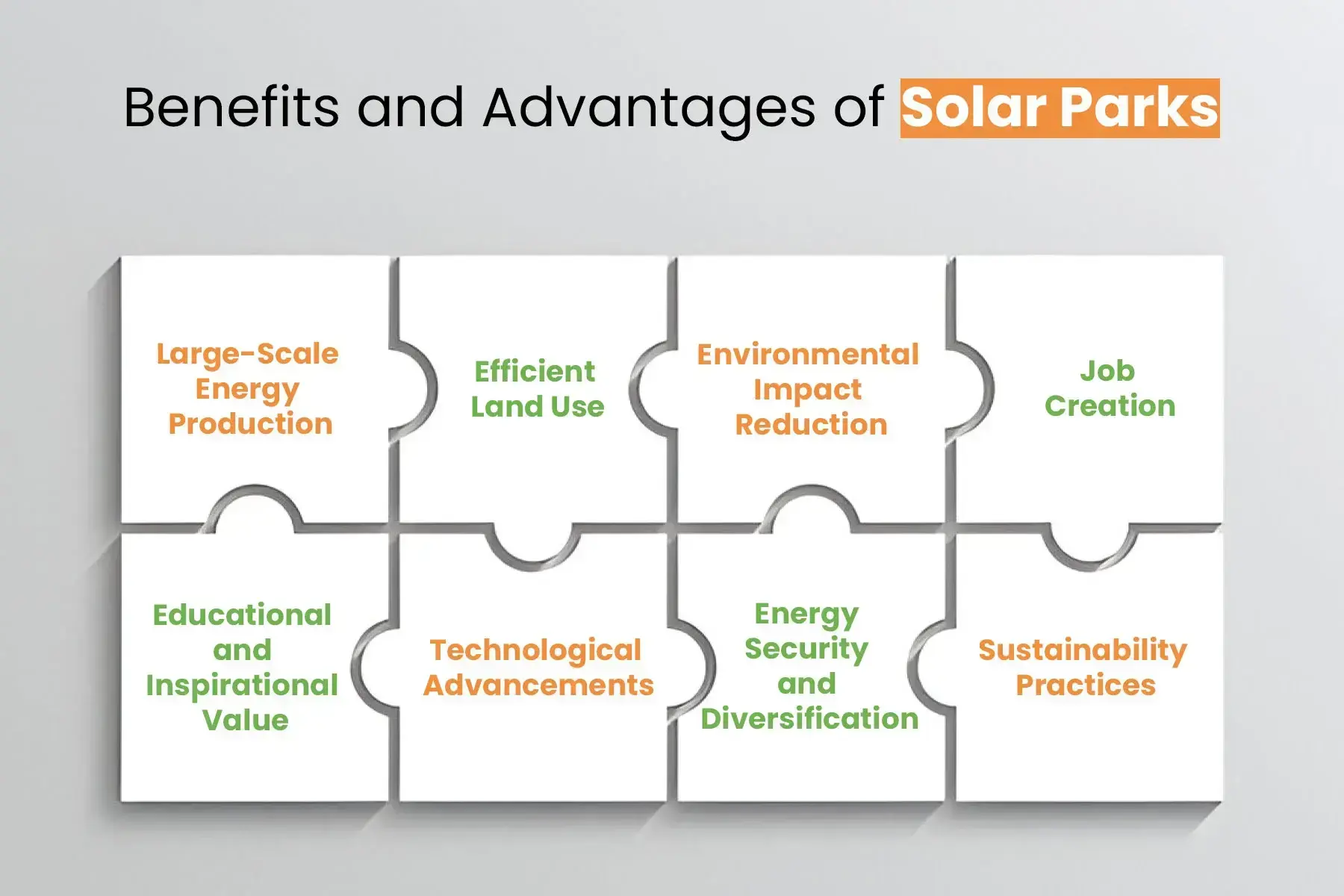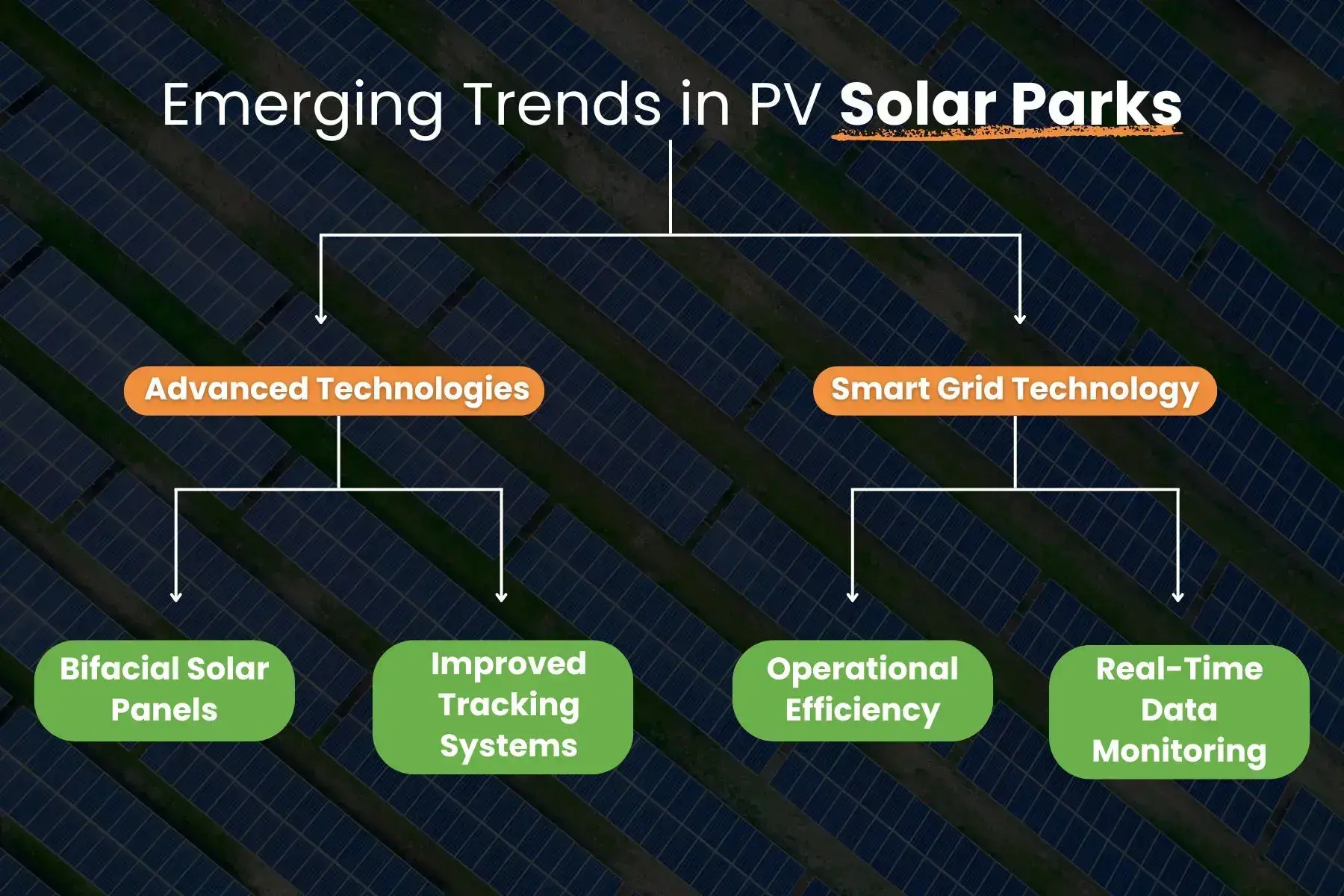What are Solar Parks? A Comprehensive Overview
Solar park, a large-scale solar panels installation, harnesses the sun’s power to generate clean, renewable electricity on a massive scale. These parks, consisting of an array of solar panels, inverters, transformers, and other components, form a centralised source of green energy. Across the globe, solar panel parks are significantly reducing carbon footprints and combating climate change.
In this article, we have provided a current state of play for solar park-based projects and why they are pivotal for optimising the use of solar energy. Later on, we will discuss basic constituents and benefits related to such projects, and the changing trends in the renewable energy segment. This guide is intended for any person who is interested in pursuing a solar power investment or maybe simply arranging to get a solar power system installation for commercial or residential use.
Understanding Solar Parks and Their Impact
solar parks have emerged as a cornerstone of the transformation As the world shifts towards renewable energy sources. These large-scale installations are not just a solution for clean energy but also a significant player in reducing global carbon emissions. In 2024, the importance of solar energy parks is even more pronounced, with advancements in technology and an increasing number of countries committing to net-zero carbon goals. These parks are not only contributing to energy security but are also driving economic growth in regions where they are established.
The Role of Solar Panel Parks in Renewable Energy
Solar panel parks are very important for the world’s progression towards the use of green energy. They are a sustainable solution when it comes to integrating them with the national power supply system; it is a reliable power source. From 2024, the pace of increasing the size of solar energy parks is increasing, especially in sunny and spacious zones. These parks apart from producing energy bring employment opportunities, boost the local industries and foster energy self-sufficiency. The solar panel parks are now gaining the acceptance and investments from the governments and private investors, and incorporating them in the energy system as a future energy solution.
In conclusion, solar panel parks are not only power plants; they are part of the overall vision and plan to adapt to climate change and move to sustainable development. The further growth and enlargement of these parks will be instrumental as the world embarks on energy consumption in the future with minimal harm to the environment.
Key Components of a Solar Energy Park
Solar energy parks consist of several key components, including solar panels, inverters, transformers, and supporting infrastructure.
Modules are the main components of Solar Energy Parks and their primary function is to harness the sun’s energy and convert it into Direct Current (DC) electricity. Among the popular types used in the contemporary utility-scale solar energy parks the monocrystalline or bifacial modules can convert more light into electricity since they collect sunlight from both sides of the cell. These panels are normally installed on tracking systems that can move with the sun so as to seize power for most part of the day.
Inverters play a crucial role in solar energy parks by converting the DC electricity from the panels into alternating current (AC), which is suitable for grid use. The latest inverters incorporate Maximum Power Point Tracking (MPPT) technology and advanced AI algorithms to optimise energy output, enhancing the overall efficiency of these parks.
Transformers increase the voltage of electricity produced so that it can be transmitted long distances without much loss. Accompanying them are strong racking and mounting structures to hold the panels especially in areas of frequent storms and strong winds.
Photovoltaic (PV ) parks Technology: Innovations and Advancements
New technologies in construction of the PV parks include perovskite solar cells, and combined power storage systems, that seeks to enhance the efficiency and sustainability. These developments make it possible for the photovoltaic parks to produce and store power due to the innovation of batteries, something that makes it possible to produce energy continuously contrary to the times when sunlight is available.
Benefits and Advantages of Solar Parks
Solar parks are an excellent idea because they have several benefits and advantages as elaborated below.

- Large-Scale Energy Production: source of clean electricity contributes greatly in coping with energy demands hence can be considered as a powerful weapon.
- Efficient Land Use: Solar panel parks are laid out to extract the maximum energy from any available space whereas the conversion of the land is done very uniformly and hence very little space is wasted.
- Environmental Impact Reduction: The use of solar energy parks minimises the use of fossil energy hence reducing the emission of greenhouse gases and therefore a better living environment.
- Job Creation: They create employment chances whereby participants engage in installation, maintenance, and management, which improves the economy of the region.
- Energy Security and Diversification: Through this aspect, much reliance is placed on non-renewable sources, hence the significance of solar parks in promoting energy diversification as a means of improving energy security.
- Technological Advancements: Technologies such as bifacial panels and single-axis tracking enhance the facilities of photovoltaic (PV) parks with higher energy accomplishment.
- Sustainability Practices: The modern solar farms also adopt recycling programmes for old panels and very careful cleaning methods which do not harm the environment in terms of water usage.
- Educational and Inspirational Value: renewable energy can be adopted as the state proves a point to policymakers and encourages other regions of adopting green energies.
The outlined key benefits emphasise the applicability of solar power plants as a chief innovation capable of boosting the progress of renewable energy practices and paving the way for the creation of energy systems less reliant on fossil fuels.
Sustainability and Efficiency in Solar energy farms
Solar energy farms are at the forefront of advancing renewable energy technology. These farms use photovoltaic (PV) cells to convert sunlight directly into electricity. The efficiency of solar farms depends on factors such as panel orientation, location, and the use of advanced materials and technologies. Recent innovations, such as bifacial solar panels and improved tracking systems, have enhanced the performance of these parks, enabling higher energy yields and better utilisation of available space.
Sustainability in solar energy parks is also achieved through the use of environment friendly materials and practices. The adoption of recycling programs for old panels and the implementation of water-saving techniques for cleaning are examples of how solar farms minimise their environmental impact while maintaining high efficiency.
Solar Parks as a Catalyst for Green Energy Adoption
Solar park serves as a critical driver for the broader adoption of green energy. By demonstrating the viability and benefits of large-scale solar power, solar power plants encourage policymakers and businesses to invest in renewable energy. The successful implementation of solar power plants showcases the potential for transitioning to a more sustainable energy system, influencing energy policies and supporting global efforts to reduce carbon emissions.
These parks also act as educational tools, raising awareness about renewable energy among the public and inspiring other regions to adopt similar initiatives. As the world shifts towards cleaner energy solutions, solar parks will continue to play a pivotal role in advancing green energy adoption and ensuring a sustainable future.
The Future of Solar Parks with Novergy: Innovations and Trends for 2024 and Beyond
As we look forward towards the year 2024, the application of solar parks in the provision of renewable energy sources is set to diversify due to innovation and growth in the market forces. Today Novergy Solar is among the leading companies that bring evolutions required to drive the future of solar energy technologies. Solar panel parks have become broader-defined and are no longer confined to the conventional definition and functions in order to accommodate new technologies and methodologies for enhanced performance and for the better conservation of the environment.
Emerging Trends in PV Solar Parks

- Advanced Technologies:
- Bifacial Solar Panels:
- Function: Capture sunlight from both sides, increasing energy generation.
- Benefit: Provides higher energy yields and improved land use efficiency.
- Improved Tracking Systems:
- Function: Adjust panel orientation to follow the sun’s movement.
- Benefit: Maximises energy capture throughout the day.
- Bifacial Solar Panels:
- Smart Grid Technology:
- Real-Time Data Monitoring:
- Function: Analyse and track energy production and distribution.
- Benefit: Optimizes energy distribution and enhances grid stability.
- Operational Efficiency:
- Function: Supports real-time adjustments and management of energy flows.
- Benefit: Contributes to more resilient and adaptable energy systems.
- Real-Time Data Monitoring:
How Solar Parks Are Shaping the Future of Renewable Energy
Solar parks are now playing a very important role in the transformation towards a renewable energy system. They can contribute to lowering a carbon footprint and fulfilling climate objectives through producing large volumes of clean power. One essential strength of these parks is its versatility, given the fact that the parks can be developed at a large scale, or at a small scale given the specific needs of the region.
The solar energy park model is also driving policies and investment to renewable energy projects, as governments and companies seek to adopt ‘best practices’ for development. Actually, as the effectiveness and reliability of solar parks are being proven, they seriously contribute to expanding the use of solar energy thus paving the way for changing the world to a more sustainable environment.

